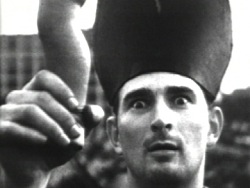Description
This legendary film features artist Jack Smith in what Jacobs calls "a look in on an exploding life, on a man of imagination suffering pre-fashionable lower East Side deprivation and consumed with American 1950's, 40's, 30s disgust. " Jacobs did little of the shooting himself, instead drawing on two unfinished films shot by Bob Fleischner. With its dissociative editing strategies, wild costumes, and scraps of music and voiceover, this baroque portrait deserves Jonas Mekas' recommendation as "the masterpiece of Baudelairean cinema."
Writes Jacobs: "Jack says I made the film too heavy. It was his and Bob's intention to create light monster-movie comedy. Two comedies, actually, two separate stories that were being shot simultaneously until they had a falling-out over who should pay for the raw stock destroyed in a fire started when Jack's cat knocked over a candle (Jack was behind in his electricity bill). Jack claimed it was an act of God and wouldn't (couldn't) pay for the burnt film. In the winter of '59, Bob showed me the footage. Having no idea of the original story plans I was able to view the material not as the fragments of a failure, of two failures, but as the makings of a new entity. Bob gave over the footage to me with the freedom to develop it as I saw fit. I think it was in late 1960 that Jack and I ignored our personal animosities long enough to record his words and songs for the sound track. The phrases he repeated for me into the tape recorder were mostly ones I'd at some time heard him say; most were pet phrases he loved to recite, over and over, his lessons, and a very few I made up in his style. This was the procedure for recording his monologues and songs: I played him selections from my 78 collection, music from the '20's and '30's, often only the beginning of a record and if he liked it we would restart the record and immediately record. I don't think there was a second take of anything, the Cult Of Spontaneity was in the air. Any lack of clarity is due to the very second-rate equipment, third-rate, fourth-rate, we were using. I play a piano harp for the Madame Nescience monologue, Jack supplied the Arabic music from his small but choice collection. There's also some SAFARI IN HIFI; a Villa-Lobos string quartet speeded up; a haunting section of a children's 45... Baby Wants To Sleep. A small amount of my own previous shooting was cut into the film, the 'drowning in nescience' color sequence near the beginning.
BLONDE COBRA is an erratic narrative -- no, not really a narrative, it's only stretched out in time for convenience of delivery. It's a look in on an exploding life, on a man of imagination suffering pre-fashionable Lower East Side deprivation and consumed with American 1950's, 40's, 30's disgust. Silly, self-pitying, guilt-strictured and yet triumphing--on one level--over the situation with style, because he's unapologetically gifted, has a genius for courage, knows that a state of indignity can serve to show his character in sharpest relief. He carries on, states his presence for what it is. Does all he can to draw out our condemnation, testing our love for limits, enticing us into an absurd moral posture the better to dismiss us with a regal 'screw-off.'"
Camera: Bob Fleischner.
Exhibition & Distribution Conditions
Please note: This work has specific screening instructions that must be followed. Please contact EAI for screening requirements.
